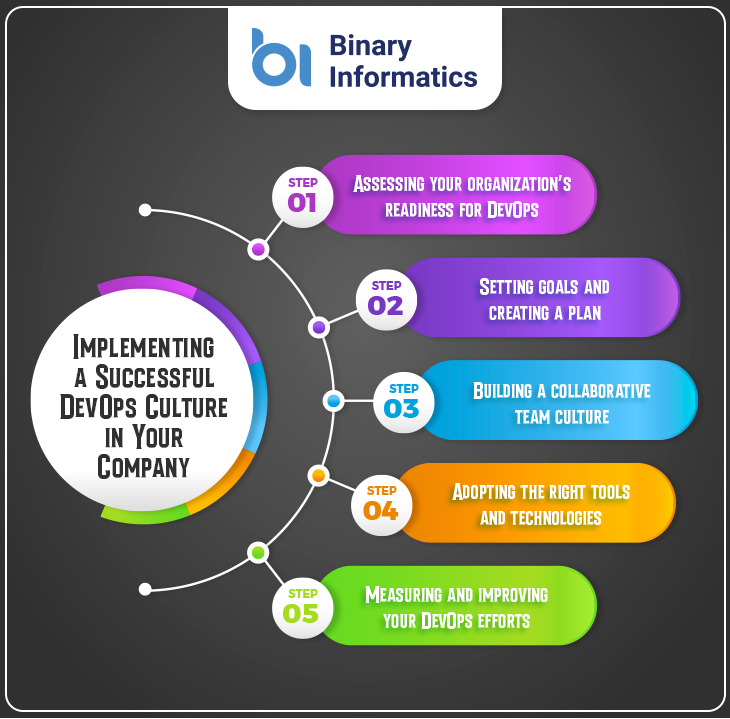However, implementing DevOps is not a one-time process, but rather a continuous journey of collaboration, communication, and improvement.
In this article, we will outline the key steps to take in order to successfully implement a DevOps culture in your organization.
Implementing a Successful DevOps Culture in Your Company

Assessing your organization’s readiness for DevOps
Before jumping into implementing DevOps, it’s important to take stock of where your organization currently stands. This includes identifying your current culture and processes, as well as evaluating the level of collaboration and communication within your team.
To get a sense of your current culture, you can conduct surveys or focus groups with team members to gather their perceptions of the current state of the organization. You can also look at objective data such as the number of defects and the time it takes to complete projects, as these can be indicators of the efficiency of your current processes.
In terms of collaboration and communication, it’s important to assess whether team members are comfortable working with each other and whether there are clear channels for communication and information sharing. This is critical for the success of DevOps, as it relies on strong collaboration and communication among team members.
You should also evaluate your current infrastructure and tools to see how well they support a DevOps workflow. This includes looking at the automation of your processes and the level of integration between your tools.
Read Also: Do you know why DevOps is important? You need to read this first
Setting goals and creating a plan
Once you have a good understanding of your organization’s current state, you can start to define your goals for implementing DevOps. This might include reducing the time it takes to complete projects, increasing efficiency, or improving the quality of your products.
With your goals in mind, you can then create a roadmap for implementing DevOps. This should include specific steps and milestones, as well as an timeline for when each step will be completed.
It’s also important to identify and address any potential roadblocks that might arise during the implementation process. This could include issues with buy-in from team members or challenges with integrating new tools and technologies.
Building a collaborative team culture
One of the key elements of a successful DevOps culture is a strong team culture that encourages collaboration and communication. This can be achieved through a number of different methods, such as:
- Encouraging team members to work closely together and share knowledge and skills
- Fostering a culture of continuous learning and improvement, where team members are encouraged to learn new technologies and processes
- Promoting a culture of accountability and ownership, where team members feel responsible for the success of their projects
- Implementing processes for gathering and acting on feedback, as well as problem-solving
Read Also: 5 DevOps Services Implementation Challenges in 2022
Adopting the right tools and technologies
The right tools and technologies are crucial for enabling a DevOps workflow. This includes both the tools used for development and testing, as well as those used for deployment and monitoring.
When evaluating and selecting tools, it’s important to consider the needs of your team and the processes you want to enable. Some common tools used in a DevOps workflow include:
- Infrastructure as code tools, such as Terraform, which allow you to automate the provisioning and management of infrastructure
- Continuous integration and delivery (CI/CD) tools, such as Jenkins and GitLab, which automate the build, test, and deployment process
- Monitoring and logging tools, such as Splunk and Elastic, which provide visibility into the performance and behavior of your systems
It’s also important to ensure that your tools are properly integrated and work seamlessly together in order to facilitate a smooth workflow. This might involve implementing APIs or integration plugins to enable communication between different tools.
Measuring and improving your DevOps efforts
Implementing DevOps is an ongoing process, and it’s important to continuously measure and improve your efforts. This can be achieved through the use of metrics, such as the time it takes to complete projects, the number of defects, and the frequency of deployments.
By gathering and analysing data on these metrics, you can identify areas for improvement and implement changes to your processes and tools. It’s also important to share successes and lessons learned with the rest of the organization in order to foster a continuous improvement mindset.
Conclusion
Implementing a successful DevOps culture requires a commitment to collaboration, communication, and continuous improvement. By assessing your organization’s readiness, setting goals, creating a plan, building a collaborative team culture, adopting the right tools. And technologies, and measuring and improving your efforts, you can create a strong DevOps culture that drives efficiency and success.
However, it’s important to remember that DevOps is an ongoing journey, and it’s important to maintain a focus on continuous improvement in order to achieve long-term success.




